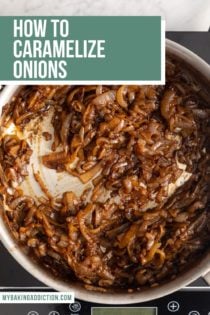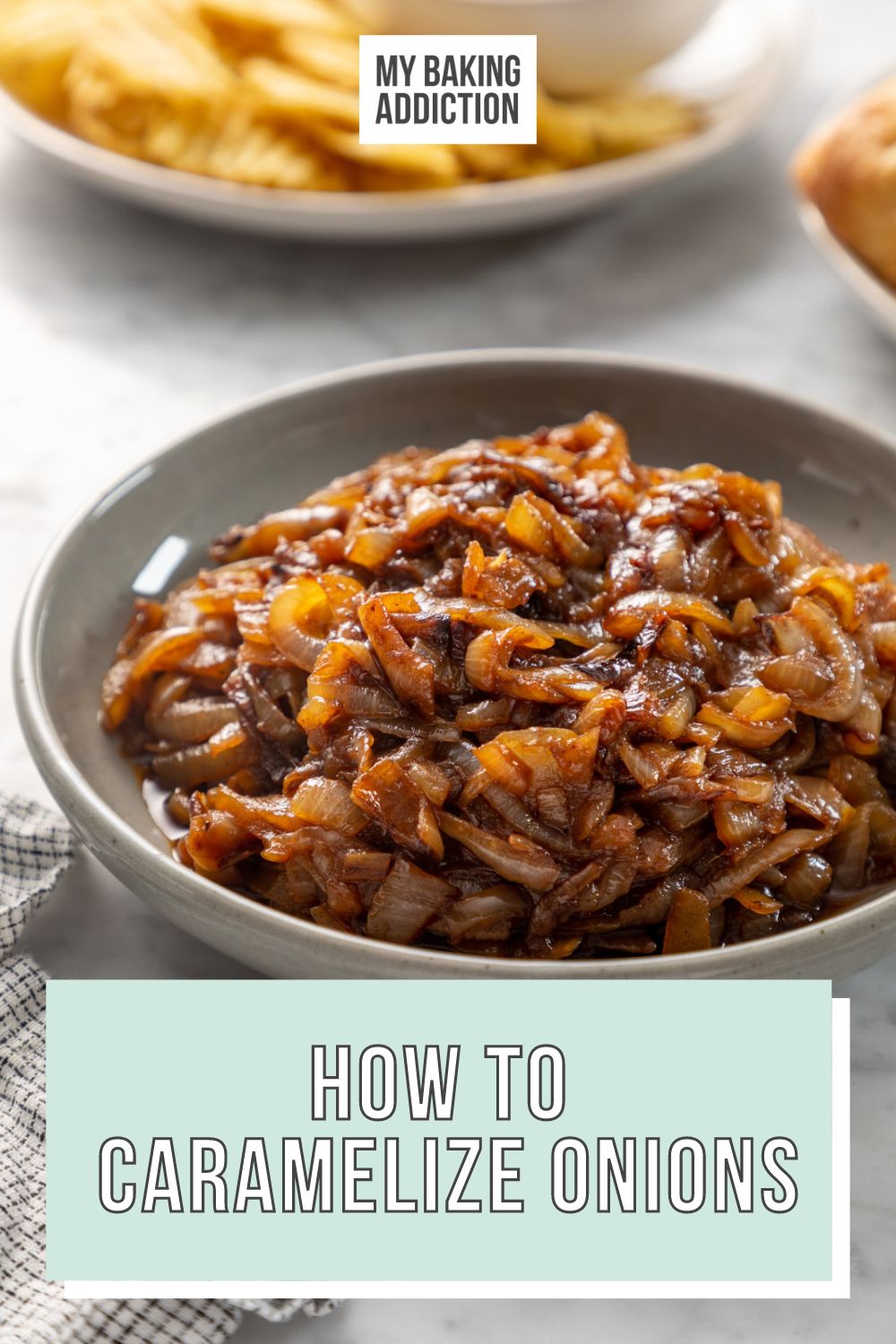This post may contain affiliate links. Please read our privacy policy.
Curious about caramelized onions? Learn everything from what they are, how to use them, and – most importantly – how to caramelize onions easily at home.
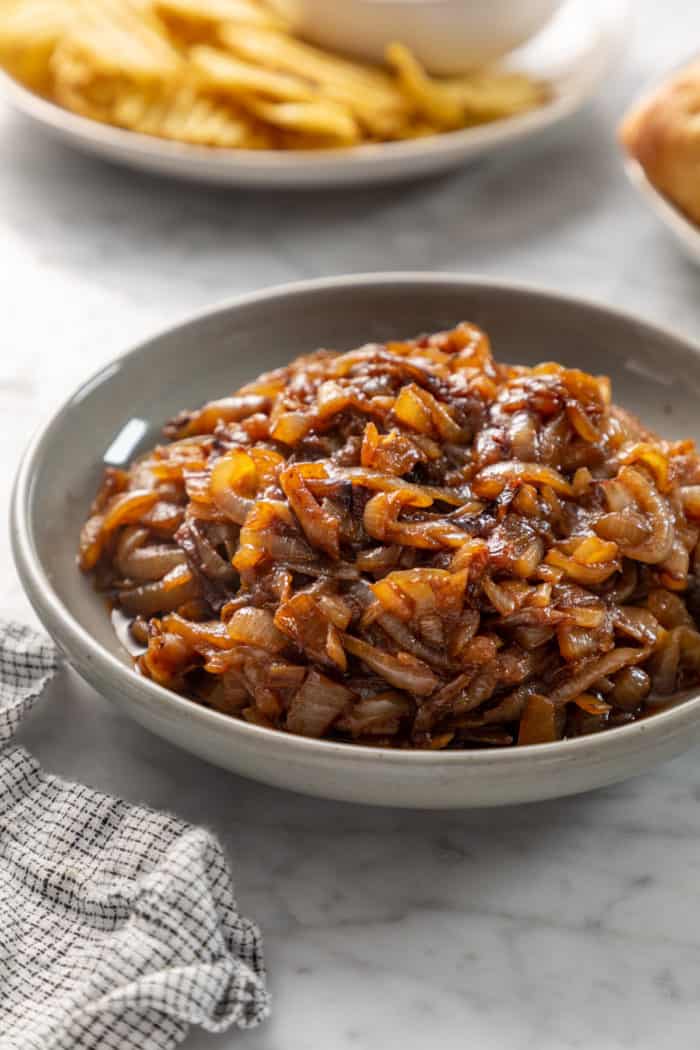
There are a handful of cooking and baking basics that I think every home cook should know.
These are things like how to make a buttermilk substitute, how to brown butter, how to roast garlic, and how to caramelize onions.
Sure, you could probably go your whole life without needing to do these things, but they’re super easy tricks that can not only make your life easier, they make your life more delicious.
I can promise that once you know how to caramelize onions, you’ll be looking for all sorts of ways to use them from breakfast to lunch to dinner.
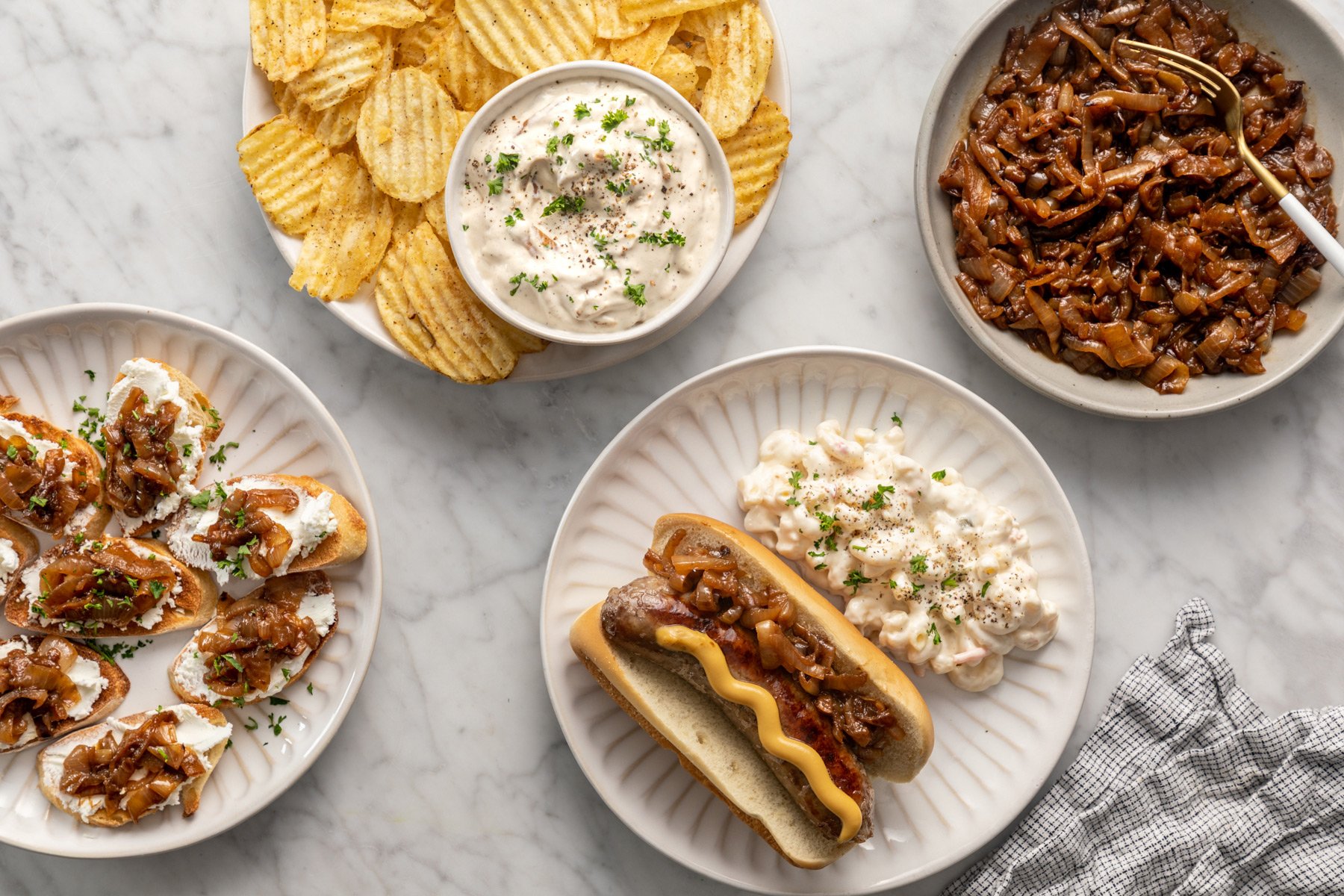
WHAT ARE CARAMELIZED ONIONS?
Caramelized onions are onions that have been cooked over low heat until the sugars in the onions turn golden (caramelize).
This means that not only are caramelized onions very soft, they also bring out the natural sweetness of the onions.
There are so many ways to use caramelized onions, making knowing how to cook them one of the best kitchen tricks to have up your sleeve. Skip down to “uses” for some of my favorite ways to use them.
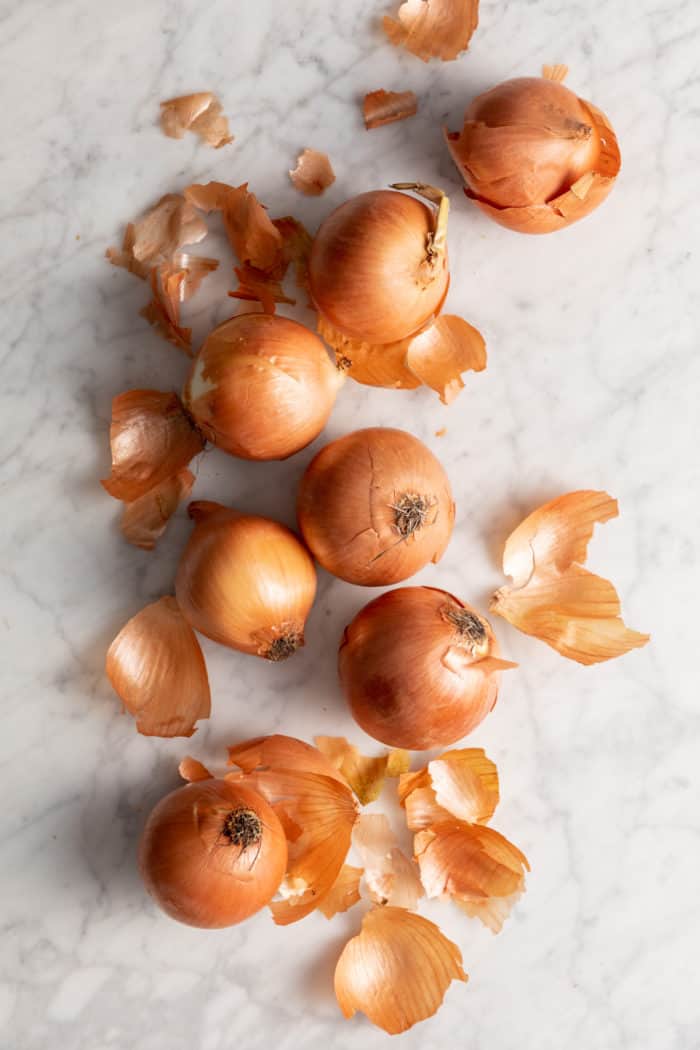
Sauteed vs caramelized onions: what’s the difference?
So what exactly is the difference between caramelized onions and sauteed onions?
Sauteed onions are cooked over medium-high to high heat so they cook very quickly. The surface of the onions brown because of the heat used.
You will also hear sizzling when you saute onions.
Caramelized onions, on the other hand, are cooked “low and slow” – they are cooked for a much longer time over low heat. Instead of the surface of the onions browning, the actual sugars in the onions are what cooks and caramelizes, turning the entire piece of onion a beautiful rich color.
You should not hear any sizzling when you are caramelizing onions. If you do, your heat is too high!
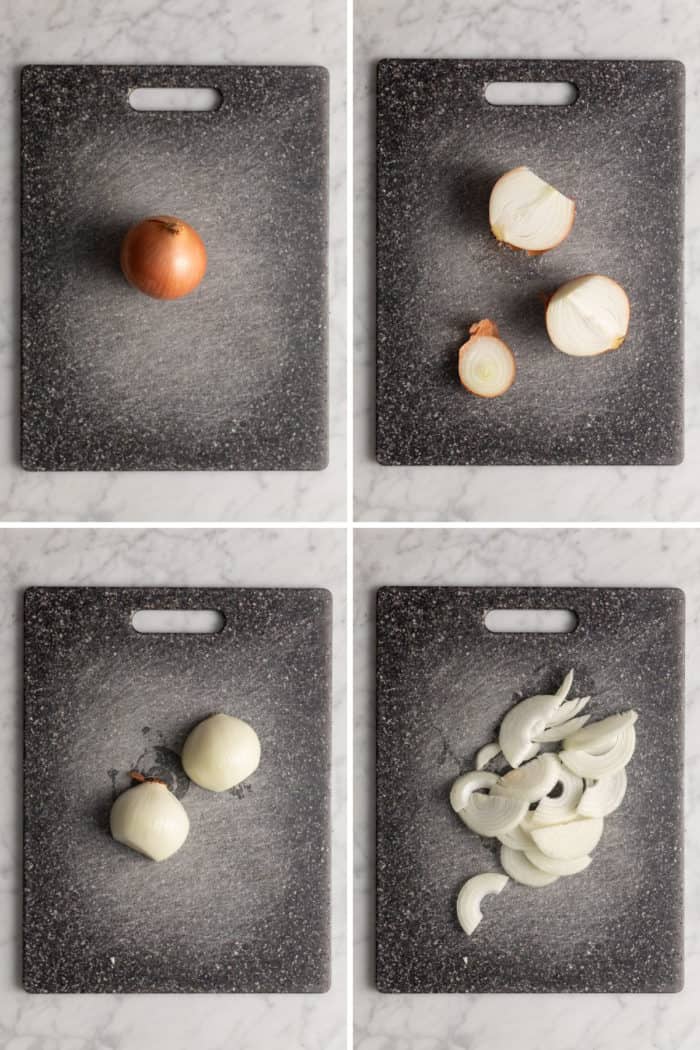
HOW TO CARAMELIZE ONIONS
Knowing how to caramelize onions is a useful skill. All you need is a few ingredients and some time. It’s a really easy process, just one that takes a bit of time to do!
What you’ll need
To make caramelized onions, you will need:
- Several onions (white, yellow, or red): You can caramelize as many onions as you want, although it’s not really worth it to do less than one full onion in my opinion. I recommend caramelizing at least two or three – you can always store extra to use later.
- Butter & olive oil: I like cooking my onions in a mixture of olive oil and butter for lots of flavor. If you’re cooking 2-3 onions, you’ll need about a tablespoon of each.
- Fine sea salt: We’ll need a little salt for our onions. I like to use fine sea salt, but there are definitely other options! Check out my guide on the types of salt for more details on various salts you could use.
- Red wine vinegar or balsamic vinegar (optional): You can choose to deglaze the pan with some vinegar at the end of cooking, but this is totally optional.
In terms of equipment, you will need:
- Sharp knife & cutting board: I like using a large chef’s knife to slice my onions. You can use a mandoline if you are slicing a lot of onions.
- Large, heavy-bottomed skillet: You’ll have the most success if you use a large skillet instead of cramming the onions into a smaller pan. Using a heavy-bottomed skillet will help evenly distribute the heat during cooking.
- Wooden spoon or a silicone spatula: For stirring the onions as they cook.
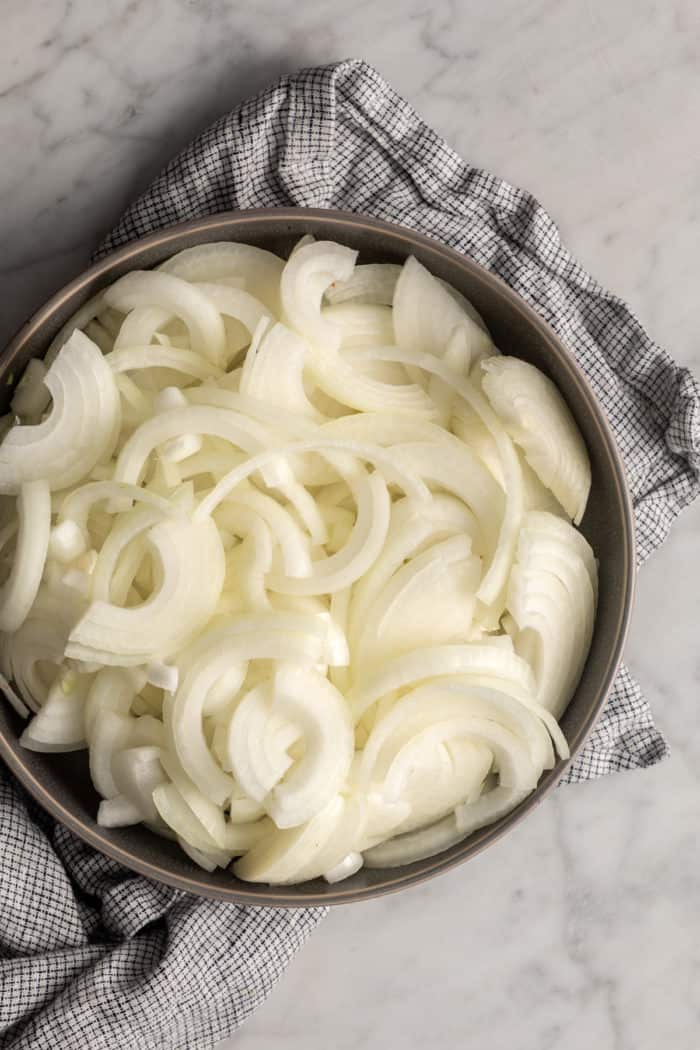
Caramelizing onions
To prep the onions, slice each one in half from the root to the stem end, then cut off the stem end and remove the peels.
Next, cut each onion half into thin slices to form half moons. Don’t worry about separating the layers of the onion – they’ll naturally separate after cutting and any that don’t will separate during cooking.
Add equal amounts of butter and olive oil to your pan. How much you need will depend on how many onions you are cooking. For 2-3 onions, you’ll need about 1 tablespoon each of butter and olive oil.
Heat the skillet over medium heat until the butter is melted and the oil is shimmering. Add the onions to the pan, stirring to coat them in the butter and olive oil, then evenly spread them out over the bottom of the pan.
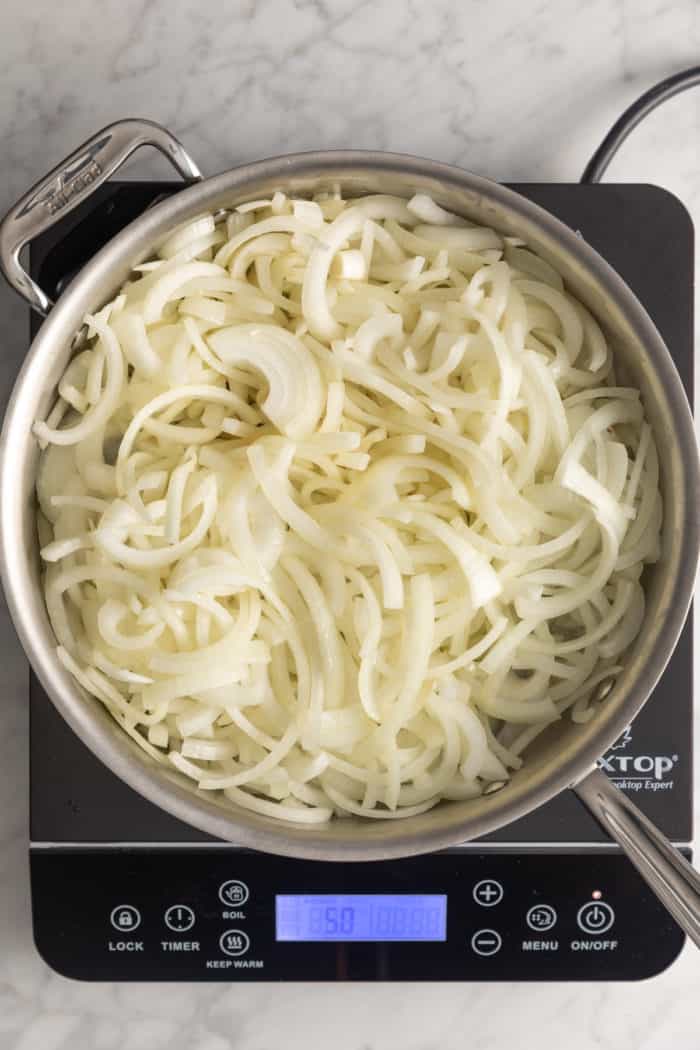
Let the onions cook, stirring occasionally. You don’t want to stir too often – they need to sit in order to properly caramelize.
Keep an eye and ear on the pan. You want the onions to cook slowly and should not hear any sizzling. If you see the onions start to brown on the outside like you would with sauteing or hear any sizzling, reduce the heat of your pan.
Once the onions have started to soften and turn translucent, season with a pinch of salt.
Keep cooking the onions, stirring occasionally, anywhere from 20-40 more minutes. Odds are good the entire process will take close to 45 minutes. You want the onions to be very soft, have reduced in volume, and be a deep caramel color.
If the onions have stuck to the bottom of the pan, you can deglaze the pan with a splash of red wine vinegar or balsamic vinegar. This will help them release from the pan and will also add some lovely flavor.
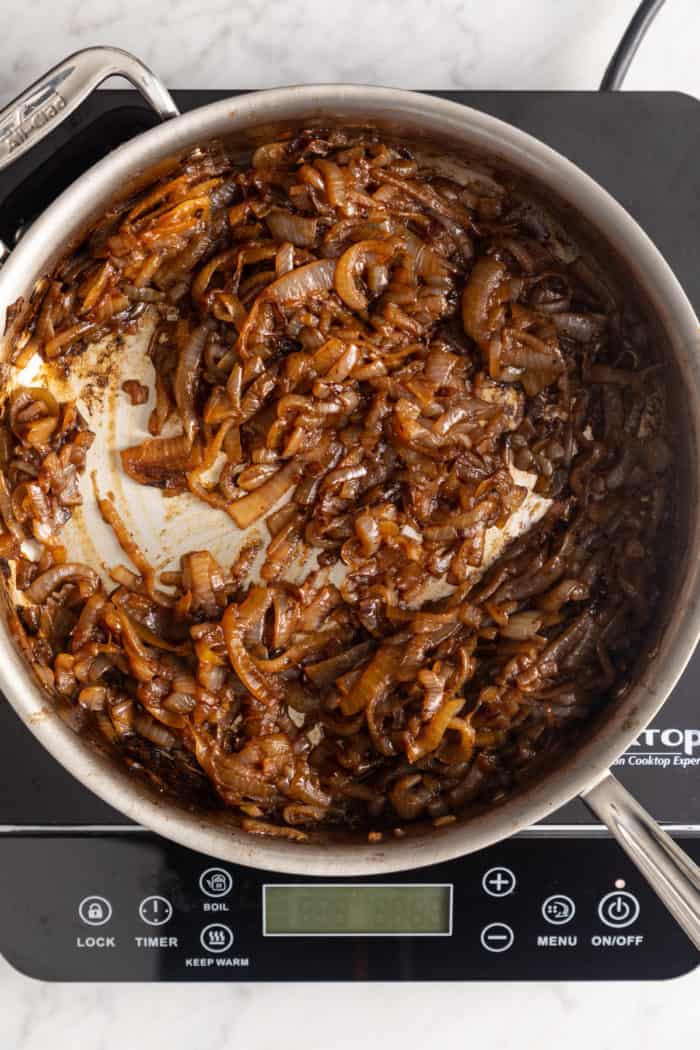
USES
Ok so now that you know how to caramelize onions, what should you do with them?
The good news is that there are endless uses for them – your imagination is the only limit!
They make an incredible topping for burgers, brats, and even steak. If you’re cooking it on the grill this summer, consider adding some caramelized onions on top!
Speaking of toppings, try using caramelized onions as a pizza topping. Use my favorite 30-minute pizza crust and top it with your favorite meats, veggies, cheeses, and caramelized onions.
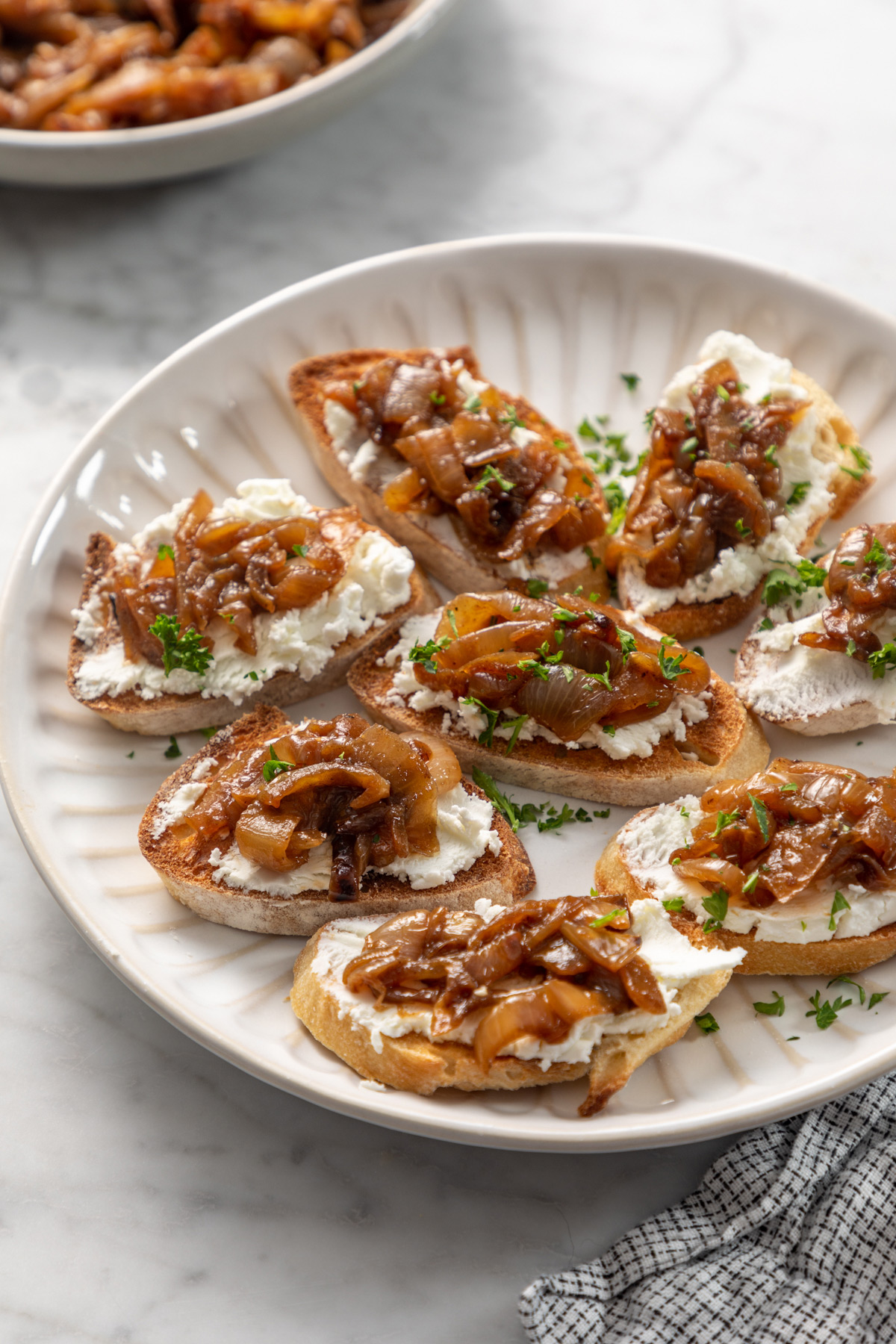
We literally wouldn’t have French onion soup without caramelized onions and they’re equally delicious in beef stew. They’re also a key part of french onion dip!
Make the best grilled cheese sandwich of your life with them! They pair perfectly with cheese, especially cheddar, goat cheese, or gruyere.
Stir them into pasta (such as pasta carbonara or fettuccine alfredo) or risotto. Add them to mac and cheese or garlic mashed potatoes!
You can even add caramelized onions to your favorite brunch dishes, such as cheese quiche or a frittata or croissant breakfast casserole.
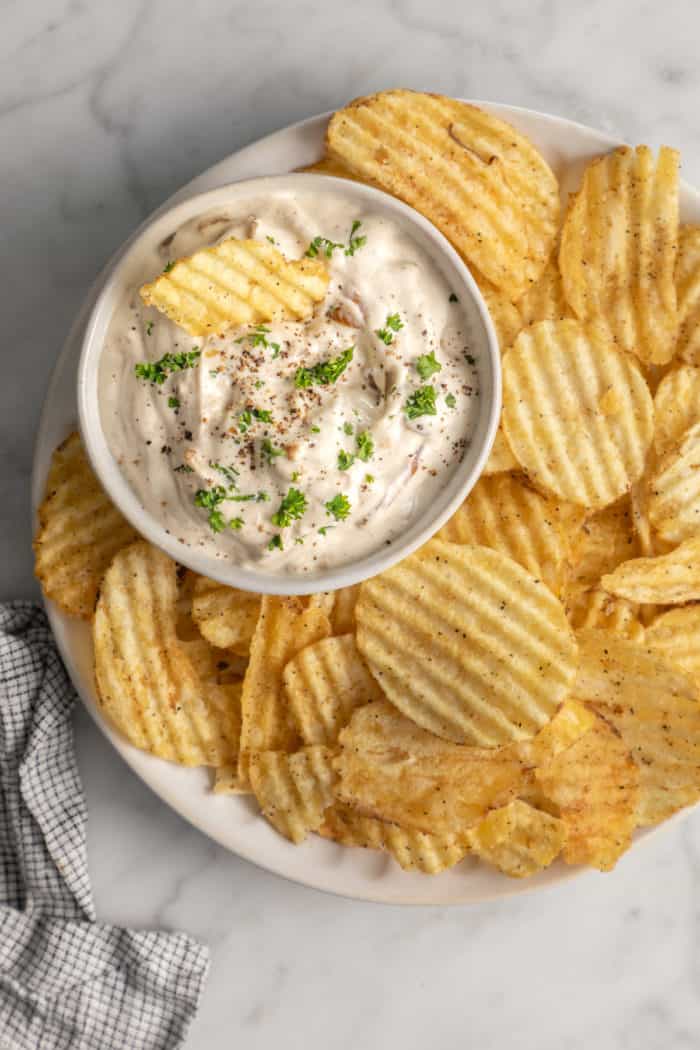
FAQS
How long does it take to caramelize onions?
Be prepared for making caramelized onions to take around 45 minutes of your time. If you’re only cooking 1 onion and using a large pan, you may be able to do it in 25-30 minutes, but more often than not it is going to take a good bit of time.
And no, you can’t really rush the process! Remember, we want the onions to caramelize, not burn.
Can you caramelize onions in advance?
Yes! Cook the onions, move them to a bowl, let them cool, and store them in an airtight container in the fridge for up to 5 days.
Can you freeze caramelized onions?
If you want to freeze your caramelized onions, put them in a vacuum-sealed bag or zip-top freezer bag with as much of the air pressed out as possible. Freeze for up to 3 months.
Keep in mind that the texture of the onions may change after freezing and thawing, so you may want to use previously frozen caramelized onions in things like quiches or casseroles where the texture isn’t as important.

Does it matter what type of onions you use?
You can caramelize any kind of onion you like!
Keep in mind that using red onions will result in a different final color – they’ll have a purple-ish hue to them.
Vidalia onions naturally have more sugar in them so they caramelize really well, but remember that means the final caramelized onions will also be sweeter.
You can even caramelize shallots if you’d like!
Do you have to use sugar?
No! Some recipes will have you add a pinch of sugar to your onions to help “speed up” the caramelization process, but that’s not really how it works.
Adding sugar will make the onions appear more caramelized, but it won’t actually speed up the way the natural sugars in the onions cook. You just have to have patience for that!
I personally skip using sugar and let the onions do what they do best on their own.
How to Caramelize Onions
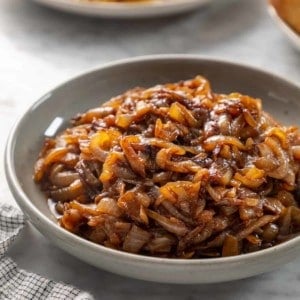
Equipment
- 15-inch Cast Iron Skillet Or other large, heavy-bottomed skillet
Ingredients
- Several onions white, yellow, or red
- Butter
- Olive oil
- Fine sea salt
- Red wine vinegar or balsamic vinegar optional
Instructions
- Slice the onions in half from the root to the stem end. Cut off the stem end and remove the peels. Cut the onions into thin slices by cutting perpendicular to the root end to form half moons. The layers of the onions will naturally separate after cutting.
- Heat a mixture of half butter and half olive oil (if you are cooking 2-3 onions, you will need about a tablespoon of each) in a large, heavy-bottomed skillet over medium heat until the butter is melted and the oil is shimmering.
- Add the onions to the pan, stirring to coat in the fat. Evenly distribute the onions across the bottom of the pan.
- Allow the onions to cook, stirring every few minutes. Try not to stir too often, though. Keep an eye on onions – you want them to slowly soften and caramelize, but not brown as you would with sauteing. Reduce the heat to medium low or low as needed.
- After the onions have started to soften and turn translucent, season with a pinch of salt. Continue to cook, stirring only occasionally, anywhere from 20-40 minutes, until the onions are very soft, have reduced in volume, and are a deep caramel color (but not burnt).
- If desired, deglaze the bottom of the pan with a splash of red wine vinegar or balsamic vinegar if the onions start to stick.
- Use as a topping on pizza, burgers or brats; in french onion soup; mix into pasta or risotto; add to quiche, etc.
